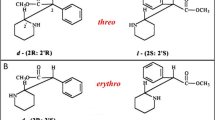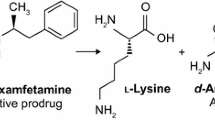Abstract
The efficacy ofd-amphetamine to support a selective bilateral intra-accumbens self-administration response was examined. Bilateral intra-accumbens infusions ofd-amphetamine were made contingent upon the acquisition of a lever-pressing response. Two identical levers were available within the operant chamber. Depression of the drug lever resulted in the intra-accumbens delivery of 1 µgd-amphetamine; responses upon the second, control lever were recorded but had no programmed consequences. Animals were not ‘primed’ with non-contingent infusions ofd-amphetamine at any time during these experiments. Nonetheless, animals readily acquired a selective response upon the drug lever. Removal of thed-amphetamine moiety from the infusate resulted in a large decline in responding, and the abolition of the selectivity of the response for the drug lever. Adulteration of the infusate with either the D1 dopamine receptor antagonist SCH-23390 or the D2 dopamine receptor antagonist sulpiride enhanced the rate of response selectively upon the drug lever. Reductions in the dose ofd-amphetamine also increased the rate of response. The effect of co-adulteration of the infusate with both SCH-23390 and sulpiride together was purely additive. The implications of these data for the methodology of intracranial drug self-administration, and the relationship between D1 and D2 dopamine receptors within the nucleus accumbens are discussed.
Similar content being viewed by others
References
Amit Z, Brown ZW, Sklar LS (1976) Intraventricular self-administration of morphine in naive laboratory rats. Psychopharmacology 48:291–294
Bozarth MA, Wise RA (1981) Intracranial self-administration of morphine into the ventral tegmental area in rats. Life Sci 28:551–555
Bozarth MA, Wise RA (1982) Localization of the reward-relevant opiate receptors. NIDA Res Monogr 41:158–164
Bozarth MA, Wise RA (1986) Involvement of the ventral tegmental dopamine system in opioid and psychomotor stimulant reinforcement. NIDA Res Monogr 67:190–196
Britton DR, Curzon P, MacKenzie RG, Kebabian JW, Williams JE, Kerkman D (1991) Evidence for involvement of both D1 and D2 receptors in maintaining cocaine self-administration. Pharmacol Biochem Behav 39:911–915
Cazala P (1990) Dose-dependent effects of morphine differentiate self-administration elicited from lateral hypothalamus and mesencephalic central gray area in mice. Brain Res 527:280–285
Cazala P, Darracq C, Saint-Marc M (1987) Self-administration of morphine into the lateral hypothalamus in the mouse. Brain Res 416:283–288
Clark D, White FJ (1987) Review: D1 dopamine receptor — the search for a function: a critical evaluation of the D1/D2 dopamine receptor classification and its functional implications. Synapse 1:347–388
Corrigall WA, Coen KM (1991) Cocaine self-administration is increased by both D1 and D2 dopamine antagonists. Pharmacol Biochem Behav 39:799–802
Creese I, Sibley DR, Hamblin MW, Leff SE (1983) The classification of dopamine receptors. Annu Rev Neurosci 6:43–71
Devine DP, Wise RA (1990) Self-administration of morphine [d-Ala2,N-Me-Phe4-Gly5-ol]-enkephalin (DAGO), and [d-Pen2,d-Pen5]-enkephalin (DPDPE) into the ventral tegmentum of the rat. Soc Neurosci Abstr 16[2]: 382.19
De Vry J, Donselaar I, Van Ree JM (1989) Intraventricular self-administration of heroin in the rat: reward seems dissociated from analgesia and physical dependence. Eur J Pharmacol 161:19–25
De Wit H, Wise RA (1977) Blockade of cocaine reinforcement in rats with the dopamine receptor blocker pimozide, but not with the noradrenergic blockers phentolamine or phenoxybenzamine. Can J Psychol 31:195–202
Dib B (1985) A study of intracerebroventricular self-administration of leucine or methionine enkephalin by rats in response to intermittent electric shocks. Pain 22:49–57
Dreher JK, Jackson DM (1989) Role of D1 and D2 dopamine receptors in mediating locomotor activity elicited from the nucleus accumbens of rats. Brain Res 487:267–277
Ettenberg A, Pettit HO, Bloom FE, Koob GF (1982) Heroin and cocaine intravenous self-administration in rats: mediation by separate neural systems. Psychopharmacology 78:204–209
Gerfen CR (1992a) D1 and D2 dopamine receptor regulation of striatonigral and striatopallidal neurons. Semin Neurosci 4:109–118
Gerfen CR (1992b) The neostriatal mosaic: multiple levels of compartmental organization. Trends Neurosci 15:133–139
Glimcher PW, Giovino AA, Hoebel BG (1987) Neurotensin self-injection in the ventral tegmental area. Brain Res 403:147–150
Goeders NE, Smith JE (1983) Cortical dopaminergic involvement in cocaine reinforcement. Science 221:773–775
Goeders NE, Smith JE (1984) Parameters of intracranial self-administration of cocaine into the medial prefrontal cortex. NIDA Res Monogr 55:132–137
Goeders NE, Smith JE (1986) Reinforcing properties of cocaine in the medical prefrontal cortex: primary action on presynaptic dopaminergic terminals. Pharmacol Biochem Behav 25:191–199
Goeders NE, Smith JE (1987) Intracranial self-administration methodologies. Neurosci Biobehav Rev 11:319–329
Goeders NE, Dworkin SI, Smith JE (1986) Neuropharmacological assessment of cocaine self-administration into the medial prefrontal cortex. Pharmacol Biochem Behav 24:1429–1440
Groenewegen HJ, Berendse HW, Meredith GE, Haber SN, Voorn P, Wolters JG, Lohman AHM (1991) Functional anatomy of the ventral, limbic system-innervated striatum. In: Willner P, Scheel-Kruger J (eds) The mesolimbic dopamine system: from motivation to action. Wiley, Chichester, pp 19–60
Hoebel BG, Monaco AP, Hernandez L, Aulisi EF, Stanley BG, Lenard L (1983) Self-injection of amphetamine directly into the brain. Psychopharmacology 81:158–163
Hubner CB, Moreton JE (1991) Effects of selective D1 and D2 dopamine antagonists on cocaine self-adminstration in the rat. Psychopharmacology 105:151–156
Iorio LC, Barnett A, Leitz FH, Houser VP, Korduba CA (1983) SCH-23390, a potential benzazepine antipsychotic with unique interactions on dopaminergic systems. J Pharmacol Exp Ther 226:462–468
Jenner P, Marsden CD (1981) Substituted benzamide drugs as selective neuroleptic agents. Neuropharmacology 20:1258–1293
Kelley AE, Delfs JM (1991) Dopamine and conditioned reinforcement. I. Differential effects of amphetamine microinjections into striatal subregions. Psychopharmacology 103:187–196
Koob GF, Goeders NE (1989) Neuroanatomical substrates of drug self-administration. In: Liebman JM, Cooper SJ (eds) Neuropharmacological basis of reward. Oxford University Press, Oxford, pp 214–263
Koob GF, Le HT, Creese I (1987) The D1 dopamine receptor antagonist SCH 23390 increases cocaine self-administration in the rat. Neurosci Lett 79:315–320
Lyness WH, Friedle NM, Moore KE (1979) Destruction of dopaminergic nerve terminals in nucleus accumbens: effect ond-amphetamine self-administration. Pharmacol Biochem Behav 11:553–556
Olds J (1959) Self-injection in the rat brain. In: Bradley BP, Deniker P (eds) Neuropsychopharmacology: Proceedings of the First International Congress of Neuropsychopharmacology. Elsevier, New York, pp 386–387
Olds J (1962) Hypothalamic substrates of reward. Physiol Rev 42:554–604
Olds J, Williams KN (1980) Self-administration ofd-Ala2-Metenkephalinamide at hypothalamic self-stimulation sites. Brain Res 194:155–170
Olds ME (1979) Hypothalamic substrate for the positive reinforcing properties of morphine in the rat. Brain Res 168:351–360
Olds ME (1982) Reinforcing effects of morphine in the nucleus accumbens. Brain Res 237:429–440
Paxinos G, Watson C (1986) The rat brain in stereotaxic coordinates, 2nd edn. Academic Press, Sydney
Pellegrino LJ, Pellegrino AS, Cushman AJ (1979) A stereotaxic atlas of the rat brain. 2nd edition. Plenum, New York
Peltier R, Schenk S (1991) GR38032F, a serotonin 5-HT3 antagonist, fails to alter cocaine self-administration in rats. Pharmacol Biochem Behav 39:133–136
Pettit HO, Ettenberg A, Bloom FE, Koob GF (1984) Destruction of dopamine in the nucleus accumbens selectively attenuates cocaine but not heroin self-administration in rats. Psychopharmacology 84:167–173
Phillips AG, Mora F, Rolls ET (1981) Intracerebral self-administration of amphetamine by rhesus monkeys. Neurosci Lett 24:81–86
Phillips GD, Willner P, Muscat R (1991) Anatomical substrates for neuroleptic-induced reward attenuation and neuroleptic-induced response decrement. Behav Pharmacol 2:129–141
Phillips GD, Robbins TW, Everitt BJ (1994a) Mesoaccumbens dopamine-opiate interactions in the control over behaviour by conditioned reinforcement. Psychopharmacology (in press)
Phillips GD, Whitelaw RB, Howes SR, Robbins TW, Everitt BJ (1994b) Isolation-rearing impairs the reinforcing efficacy of intravenous cocaine or intra-accumbensd-amphetamine: impaired response to intraaccumbens D1 and D2/3 dopamine receptor antagonists. Psychopharmacology (in press)
Plaznik A, Stefanski R, Kostowski W (1989) Interaction between accumbens D1 and D2 receptors regulating rat locomotor activity. Psychopharmacology 99:558–562
Risner ME, Jones BE (1980) Intravenous self-administration of cocaine and norcocaine by dogs. Psychopharmacology 71:83–89
Roberts DC, Corcoran ME, Fibiger HC (1977) On the role of ascending catecholaminergic systems in intravenous self-administration of cocaine. Pharmacol Biochem Behav 6:615–620
Roberts DC, Koob GF, Klonoff P, Fibiger HC (1980) Extinction and recovery of cocaine self-administration following 6-hydroxyydopamine lesions of the nucleus accumbens. Pharmacol Biochem Behav 12:781–787
Roberts DC, Dalton JC, Vickers GJ (1987) Increased self-administration of cocaine following haloperidol: effect of ovariectomy, estrogen replacement, and estrous cycle. Pharmacol Biochem Behav 26:37–43
Roberts DC, Loh EA, Vickers G (1989) Self-administration of cocaine on a progressive ratio schedule in rats: dose-response relationship and effect of haloperidol pretreatment. Psychopharmacology 97:535–538
Robinson TE, Becker JB (1986) Enduring changes in brain and behavior produced by chronic amphetamine administration: a review and evaluation of animal models of amphetamine psychosis. Brain Res Rev 11:157–198
Robledo P, Maldonado-Lopez R, Koob GF (1992) Role of dopamine receptors in the nucleus accumbens in the rewarding properties of cocaine. Ann NY Acad Sci 654:509–512
Smith BR, Brown ZW, Amit Z (1982) Intraventricular self-administration of leucine-enkephalin by laboratory rats. Life Sci 31:1527–1530
Sokoloff P, Giros B, Martres M-P, Bouthenet M-L, Schwartz JC (1990) Molecular cloning and characterization of a novel dopamine receptor (D3) as a target for neuroleptics. Nature 347:146–151
Sunahara RK, Guan H-C, O'Dowd BF, Seeman P, Laurier LG, Ng G, George SR, Taylor JR, Robbins TW (1986) 6-hydroxydopamine lesions of the nucleus accumbens, but not of the caudate nucleus, attenuate enhanced responding with reward-related stimuli produced by intra-accumbensd-amphetamine. Psychopharmacology 90:390–397
Torchia J, Van Tol HHM, Niznik HB (1991) Cloning of the gene for a human dopamine D5 receptor with higher affinity for dopamine than D1. Nature 350:614–619
Van Ree JM, De Wied D (1980) Involvement of neurohypophyseal peptides in drug-mediated adaptive responses. Pharmacol Biochem Behav 13:257–263
Van Tol HHM, Bunzow JR, Guan HC, Sunahara RK, Seeman P, Niznik HB, Civelli O (1991) Cloning of the gene for a human dopamine D4 receptor with high affinity for the antipsychotic clozapine. Nature 350:610–619
Welzl H, Kuhn G, Huston JP (1989) Self-administration of small amounts of morphine through glass micropipettes into the ventral tegmental area of the rat. Neuropharmacology 28:1017–1023
Winer BJ (1971) Statistical principles in experimental design. McGraw-Hill, New York
Wise RA, Hoffman DC (1992) Localization of drug reward mechanisms by intracranial injections. Synapse 10:247–263
Wolterink G, Phillips G, Cador M, Donselaar-Wolterink I, Robbins TW, Everitt BJ (1993) Relative roles of ventral striatal D1 and D2 dopamine receptors in responding with conditioned reinforcement. Psychopharmacology 110:355–364
Woolverton WL (1986) Effects of a D1 and a D2 dopamine antagonist on the self-administration of cocaine and piribedil by rhesus monkeys. Pharmacol Biochem Behav 24:531–535
Yokel RA, Wise RA (1975) Increased lever pressing for amphetamine after pimozide in rats: implications for a dopamine theory of reward. Science 187:547–549
Yokel RA, Wise RA (1976) Attenuation of intravenous amphetamine reinforcement by central dopamine blockade in rats. Psychopharmacology 48:311–318
Author information
Authors and Affiliations
Rights and permissions
About this article
Cite this article
Phillips, G.D., Robbins, T.W. & Everitt, B.J. Bilateral intra-accumbens self-administration ofd-amphetamine: Antagonism with intra-accumbens SCH-23390 and sulpiride. Psychopharmacology 114, 477–485 (1994). https://doi.org/10.1007/BF02249339
Received:
Revised:
Issue Date:
DOI: https://doi.org/10.1007/BF02249339




